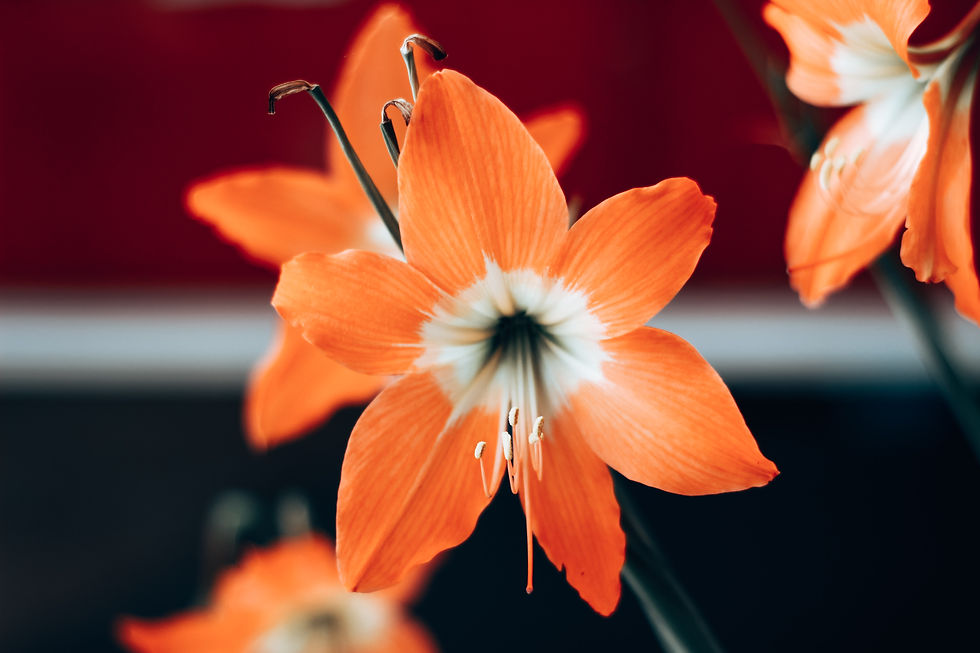Amaryllis
- Henleaze Garden Shop

- Oct 26, 2021
- 3 min read
Updated: Mar 25, 2022

The flamboyant blooms of amaryllis (Hippeastrum) are a stunning sight that are all the more welcome in the depths of winter and early spring. They’re easy to grow, and take between six to eight weeks to flower.
Like many bulbs, including lilies, all parts of amaryllis are poisonous to cats and dogs, so it’s a good idea to grow them in areas they can’t reach.
How to grow
Soak the amaryllis bulbs for a few hours to help rehydrate the roots and speed up the growth process. Fill a pot with compost and sit the bulb on top – don’t use a pot that’s too big: amaryllis do best when pot bound. Top up with compost and water well. Leave your amaryllis bulb in a warm, dark place for a couple of weeks. When a shoot appears, move to a bright spot without direct sunlight.

Amaryllis take six to eight weeks to bloom after planting. By staggering the planting, you can enjoy flowers right up to Easter. Use the eight-week rule; just count back from the desired blooming period. If you want blooms for Christmas, plant in September.
From spidery cybisters to 75cm-tall giants, all amaryllis have the same requirements. They’re best suited to a rich, very well drained growing medium, in a warm, light spot. Provide this by incorporating grit or sand, and leaf mould or well-rotted manure into multi-purpose compost.
Half fill the pot with peat-free, multi-purpose compost, breaking up any lumps and lightly firming it in place with your fingers. Set the bulb in place, making sure the top sits just above the pot. Fill around the bulb with compost and firm gently. Water well and allow the pot to drain.
Keep your amaryllis in a cool room with plenty of light as this will allow it to develop slowly, maintaining a strong flower shoot and leaves. Once in bloom you may need to support the flower spikes with canes.
Not just a one trick pony - it flowers again & again!
Don’t throw your amaryllis out after it’s flowered. With a little care, it’s easy to get it to bloom again. Once your amaryllis has flowered, the bulb keeps growing, so it’s worth repotting it into a slightly larger container. Part-fill with fresh, peat-free compost and plant the bulb as you did in autumn. Remove the flower bud, snipping it off at the base, so the plant diverts its energy from seed production. Once potted up water well, but let the compost dry out between watering.

In late spring, after all risk of frost has passed, pop your amaryllis outside for summer. Water and feed with a liquid fertiliser weekly, to keep the leaves in growth, which in turn feeds the bulb. Then stop watering completely in August to encourage a dormancy period of around eight weeks. The leaves will turn yellow and start to die down.
In mid-October bring your amaryllis back inside and start watering again. The combination of dormancy and cool night temperatures will initiate the flower buds.
Problems
The main problems when growing amaryllis are associated with over-watering. Amaryllis need very free-draining compost, and so watering too much can lead to fungal infections. Symptoms include yellowing leaves and a droopy stem. You may not be able to remedy the problems once arisen, but in future make sure your bulbs grow in free-draining compost and the pot never sits in water.
Other causes of a droopy stem can be too much warmth, which encourages the stem to grow too quickly. Use a cane to support it and grow in cooler conditions the following year.
Mosaic virus can be a problem for amaryllis. Infected plants have yellow streaking on the leaves and become weaker with age, eventually growing and flowering less. There’s nothing you can do here, apart from destroy the bulb and start again.
Insects can become a problem in greenhouses, these include scale, mites, thrips, bulb maggots and mealybugs. Speak to our staff in store for advice on removing these insects.







Comments